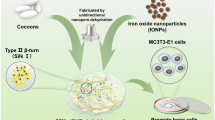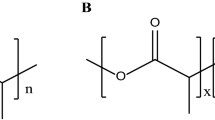Abstract
In this study, we prepared injectable collagen microspheres for the sustained delivery of recombinant human vascular endothelial growth factor (rhVEGF) for tissue engineering. Collagen solution was formed into microspheres under a water-in-oil emulsion condition, followed by crosslinking with water-soluble carbodiimide. Various sizes of collagen microspheres in the range of 1–30 μm diameters could be obtained by controlling the surfactant concentration and rotating speed of the emulsified mixture. Particle size proportionally decreased with increasing the rotating speed (1.8 μm per 100 rpm increase in the range of 300–1,200 rpm) and surfactant concentration (3.1 μm per 0.1% increase in the range of 0.1–0.5%). The collagen microspheres showed a slight positive charge of 8.86 and 3.15 mV in phosphate-buffered saline and culture medium, respectively. Release study showed the sustained release of rhVEGF for 4 weeks. Released rhVEGF was able to induce capillary formation of human umbilical vein endothelial cells, indicating the maintenance of rhVEGF bioactivity after release. In conclusion, the results suggest that the collagen microspheres have potential for sustained release of rhVEGF.






Similar content being viewed by others
References
Cross MJ, Claesson-Welsh L. FGF and VEGF function in angiogenesis: signalling pathways, biological responses and therapeutic inhibition. Trends Pharmacol Sci. 2001;22(4):201–7.
Morishita M, Peppas NA. Is the oral route possible for peptide and protein drug delivery? Drug Discov Today. 2006;11(19–20):905–10.
De la Riva B, Nowak C, Sanchez E, Hernandez A, Schulz-Siegmund M, Pec MK, et al. VEGF-controlled release within a bone defect from alginate/chitosan/PLA-H scaffolds. Eur J Pharm Biopharm. 2009;73(1):50–8.
Lee J, Lee KY. Local and sustained vascular endothelial growth factor delivery for angiogenesis using an injectable system. Pharm Res. 2009;26(7):1739–44.
Bagal A, Dahiya R, Tsai V, Adamson PA. Clinical experience with polymethylmethacrylate microspheres (Artecoll) for soft-tissue augmentation: a retrospective review. Arch Facial Plast Surg. 2007;9(4):275–80.
Kim HW, Gu HJ, Lee HH. Microspheres of collagen-apatite nanocomposites with osteogenic potential for tissue engineering. Tissue Eng. 2007;13(5):965–73.
Kim SS, Gwak SJ, Choi CY, Kim BS. Skin regeneration using keratinocytes and dermal fibroblasts cultured on biodegradable microspherical polymer scaffolds. J Biomed Mater Res B Appl Biomater. 2005;75(2):369–77.
Berthold A, Cremer K, Kreuter J. Collagen microparticles: carriers for glucocorticosteroids. Eur J Pharm Biopharm. 1998;45(1):23–9.
Hwang SM, Kim DD, Chung SJ, Shim CK. Delivery of ofloxacin to the lung and alveolar macrophages via hyaluronan microspheres for the treatment of tuberculosis. J Control Release. 2008;129(2):100–6.
Mathew ST, Devi SG, Kv S. Formulation and evaluation of ketorolac tromethamine-loaded albumin microspheres for potential intramuscular administration. AAPS PharmSciTech. 2007;8(1):14.
Wei HJ, Yang HH, Chen CH, Lin WW, Chen SC, Lai PH, et al. Gelatin microspheres encapsulated with a nonpeptide angiogenic agent, ginsenoside Rg1, for intramyocardial injection in a rat model with infarcted myocardium. J Control Release. 2007;120(1–2):27–34.
Nagai N, Yunoki S, Suzuki T, Sakata M, Tajima K, Munekata M. Application of cross-linked salmon atelocollagen to the scaffold of human periodontal ligament cells. J Biosci Bioeng. 2004;97(6):389–94.
Nagai N, Hirakawa A, Otani N, Munekata M. Development of tissue-engineered human periodontal ligament constructs with intrinsic angiogenic potential. Cells Tissues Organs. 2009;190(6):303–12.
Olde Damink LH, Dijkstra PJ, van Luyn MJ, van Wachem PB, Nieuwenhuis P, Feijen J. Cross-linking of dermal sheep collagen using a water-soluble carbodiimide. Biomaterials. 1996;17(8):765–73.
Kosmulski M, Prochniak P, Rosenholm JB. Solvents, in which ionic surfactants do not affect the zeta potential. J Colloid Interface Sci. 2010;342(1):110–3.
Sethi M, Joung G, Knecht MR. Stability and electrostatic assembly of au nanorods for use in biological assays. Langmuir. 2009;25(1):317–25.
Yao C, Roderfeld M, Rath T, Roeb E, Bernhagen J, Steffens G. The impact of proteinase-induced matrix degradation on the release of VEGF from heparinized collagen matrices. Biomaterials. 2006;27(8):1608–16.
Wallace DG, Rosenblatt J. Collagen gel systems for sustained delivery and tissue engineering. Adv Drug Deliv Rev. 2003;55(12):1631–49.
Swatschek D, Schatton W, Muller W, Kreuter J. Microparticles derived from marine sponge collagen (SCMPs): preparation, characterization and suitability for dermal delivery of all-trans retinol. Eur J Pharm Biopharm. 2002;54(2):125–33.
Chan OC, So KF, Chan BP. Fabrication of nano-fibrous collagen microspheres for protein delivery and effects of photochemical crosslinking on release kinetics. J Control Release. 2008;129(2):135–43.
Nagai N, Nakayama Y, Zhou YM, Takamizawa K, Mori K, Munekata M. Development of salmon collagen vascular graft: mechanical and biological properties and preliminary implantation study. J Biomed Mater Res B Appl Biomater. 2008;87(2):432–9.
Acknowledgments
This work was supported by Takeda Science Foundation and the Research for Promoting Technological Seeds from Japan Science and Technology Agency. We thank Shunji Yunoki PhD, Risa Itoh and Masanobu Munekata PhD, Hokkaido University, for helpful advices and technical assistances. We thank Sysmex for measurements of zeta potential and helpful advices.
Author information
Authors and Affiliations
Corresponding author
Rights and permissions
About this article
Cite this article
Nagai, N., Kumasaka, N., Kawashima, T. et al. Preparation and characterization of collagen microspheres for sustained release of VEGF. J Mater Sci: Mater Med 21, 1891–1898 (2010). https://doi.org/10.1007/s10856-010-4054-0
Received:
Accepted:
Published:
Issue Date:
DOI: https://doi.org/10.1007/s10856-010-4054-0




